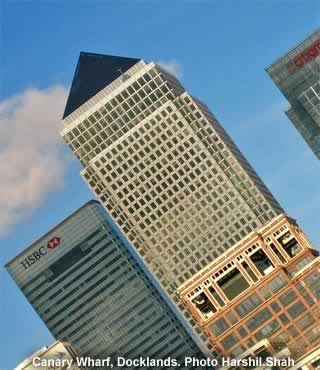Docklands |
|
 |
|||
Old docks that are now the home of large companies |
||
The Docklands area spreads out east from the city of London, along the banks of the Thames. For the entire 19th century, and much of the 20th, it was one of busiest docks on the planet. Despite this, in recent decades, its function and identity has been transformed completely. Business began to fade away halfway through the 20th century. Throughout the 60s and 70s, the fortunes of the area really started to change. The very last sections of docks were finally closed in the 80s. This left an area of 20 square kilometres almost completely derelict. Since then, the Docklands have somehow become one of the city's biggest commercial and financial districts. In just two decades, its population more than doubled, and in terms of business, it now rivals central London in importance. |
||
The Docklands' talisman is its biggest and most recognisable area, Canary Wharf. This small section of London holds the UK's three tallest buildings, and many other skyscrapers besides. The record-holder is the Canary Wharf Tower, at One Canada Square. The skyline is already impressive, but more towers are planned, so who knows how it'll end up. Major financial companies use most of the space in these gigantic buildings, but there are four different shopping centres as well, which draw people in from all the surrounding areas, and beyond. |
||
Another nearby development is the West India Quay. It was converted from huge old warehouses, which were used to store such goods as tea and sugar. Nowadays, the area is filled with plenty of restaurants, and has a reputation as a good place to eat. Also here is the Museum of London, Docklands, which is a branch of the main Museum of London in the Barbican. The exhibitions tell the stories of all the river's previous users, from the Romans, to the slave traders. There are full, life-size reconstructions of scenes from London's past, including an 1840's Docklands street, packed with drunken sailors on shore leave. |
||
Also on the banks of the Thames, almost within a stone's throw of Canary Wharf's glass and steel monoliths, is an unusual sight. Mudchute is the biggest farm in London, and it contains everything a farm should, from trees, grass, and wooden fences, to grazing cows, pigs and sheep. The farm also runs a restaurant, and offers horse riding lessons! |
||
The area is capable of throwing up a few surprises like this. Another is the SS Robin, an old 19th century steamship, which is the world's best remaining example of this type of vessel. Its cargo hold was previously used for transporting goods around both the UK and Spain, but it has now been converted into an unusual art space. |
||
But for every reminder of the Docklands' past, there's an even bigger example of its present. A colossal example is the O2 Dome. This huge entertainment complex was formerly known as the Millennium Dome, and was built to celebrate the beginning of the year 2000. Following a redevelopment in the middle of the decade, it recently reopened in its new guise. The O2 aspires to be the biggest, best, and most popular centre of entertainment in the capital, and to that end, it includes several huge venues for music, art, film, and more, as well as dozens of bars and restaurants. |
||
If you want to explore the riverside area, and everything it has to offer, then the best method is via its very own train lines, the Docklands Light Railway. Since its inception, it has proven to be one of London's cheapest and most reliable transport systems. |
||
|
||
Museum of London Docklands is open daily, 10am to 6pm. Entry is FREE. West India Quay, Canary Wharf, London, E14 4AL. Tel: 0207 001 9844 |
||
|
Pocket Britain is optimised for use on a smartphone or tablet with internet access. All content is subject to copyright. All reasonable methods have been used to ensure information supplied is accurate at the time of publication. However, it is advisable to check information before relying on it. Privacy Policy |